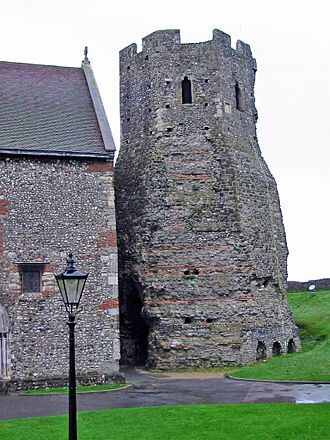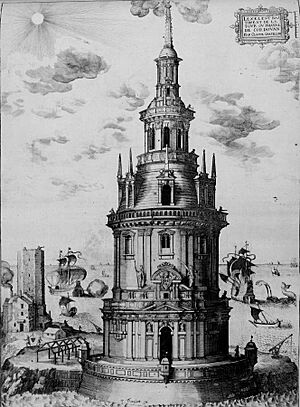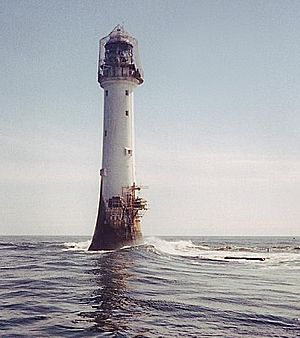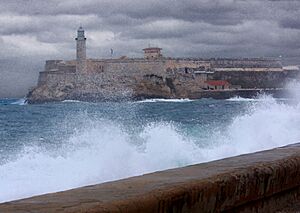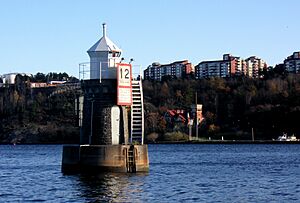History of lighthouses facts for kids
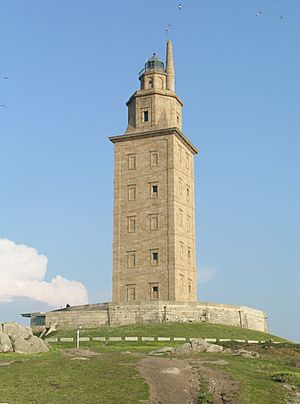
Lighthouses are special towers or buildings that help ships find their way at sea or on rivers. They guide sailors and warn them about dangerous places like rocks or shallow waters. For thousands of years, people have used different ways to create lights to help ships navigate.
Contents
Early Lighthouses
Long ago, before there were proper ports, sailors used fires built on hilltops to find their way. People soon realized that if they raised the fire higher, it would be seen from further away. This led to building platforms for the fires, which were the very first lighthouses.
In ancient times, lighthouses mostly showed sailors where the entrance to a port was. They weren't usually used to warn about hidden rocks or dangerous areas like many modern lighthouses do. Some experts think a square watchtower found in Kuntasi, India, might have been a lighthouse around 2000 BCE. It was 10-12 meters tall and helped guide boats.
Greek and Roman Times
Ancient stories say that Palamedes invented the first lighthouse. But we know for sure that famous lighthouses existed, like the incredible Lighthouse of Alexandria and the Colossus of Rhodes. In the 5th century BC, Themistocles built a small stone column with a fire beacon at the port of Piraeus in Greece.
A Greek poet named Lesches wrote about a lighthouse at Sigeion around 660 BC. This might have been the first light that was regularly kept burning to help sailors.
We know a lot about ancient lighthouses from descriptions and drawings of the Pharos of Alexandria. This huge tower was built in the 3rd century BC but fell during an earthquake many centuries later. The Tower of Hercules in Spain still has its Roman core. The ruins of the Dover lighthouse in England also show us how they were built. We can also see lighthouses on old coins and mosaics, especially the one at Ostia.
These old buildings help us understand what lighthouses looked like. But it's harder to know how their lights worked. People probably burned wood or coal to keep the fires going all night. The Tower of Hercules even has a large chimney for smoke.
Lighthouse keepers might have added liquids to the fire to make it burn brighter and stay steady in strong winds. It's also possible that glass windows protected the light from the wind. Large mirrors might have helped to send the light beam further. Keeping these lights going would have needed a lot of work to bring fuel and tend the flames.
Old pictures of lighthouses can be tricky. Lighthouses on Roman coins, carvings, and mosaics don't always show exactly what they looked like. Most show a building with two or three levels that gets narrower at the top. The small size of coins might have made artists change the image. So, these pictures are more like symbols than exact copies of real lighthouses.
Lighthouses in Europe
During the Middle Ages in Europe, many Roman lighthouses stopped being used. But some kept working, like the Tower of Hercules in Spain and the Lanterna in Italy. As navigation got better, lighthouses started to appear more in Western and Northern Europe.
One of Europe's oldest working lighthouses is Hook Lighthouse in Ireland. It was built in the Middle Ages and has a strong, round design.
Later, around the 1300s, a 40-foot (12-meter) tower was built by Edward the Black Prince at Cordouan in France. A hundred years later, in 1581, King Henri III asked an architect named Louis de Foix to build a new one. This lighthouse took 27 years to build and was finished in 1611. The Cordouan lighthouse was a symbol of France's power at sea. It even had fancy rooms inside for the king. Its top part was rebuilt later, making it taller and adding a new type of lamp and mirrors. It was also the first to use the amazing Fresnel lens in the early 1820s.
In Britain, lighthouses used to be owned by private people. They could charge ships money to use the light. This caused problems, as some owners charged too much. This led to ships avoiding the English coast and even some shipwrecks.
To fix this, Trinity House, a group that manages lighthouses in England, built the Lowestoft Lighthouse in 1609. It had two wooden towers with candle lights. For a long time, lighthouses used candles, coal, or wood fires. But things improved in 1782 with the Argand lamp, which burned oil. Then came the first mirrored reflector in 1777 and Fresnel’s special lens system in 1823. The Nore lightship, the world's first floating light, was set up in 1732.
After some changes in the law in 1836, Trinity House took over all private lighthouses. They had to spend a lot of money buying them back from the owners. For example, they paid £444,000 for the Skerries Lighthouse.
Modern Lighthouses
The modern age of lighthouses began around the 1700s. More ships were sailing across the Atlantic Ocean, so more lighthouses were needed. New building methods and better lighting allowed for bigger and stronger lighthouses, even in the open sea. Lighthouses then became important for warning ships about dangers like rocks or reefs.
Eddystone Lighthouse
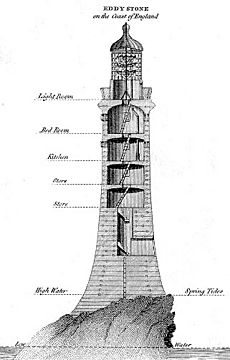
The Eddystone Rocks near Plymouth Sound, England, were very dangerous for ships. Many ships were wrecked there. It was very hard to build anything on these rocks because of the strong waves.
The first attempt was a wooden tower built by Henry Winstanley from 1696 to 1698. But a huge storm in 1703 destroyed it. After this, a Captain Lovett got permission to charge ships a small fee to pass the rocks. He hired John Rudyard to design a new lighthouse. This one was a cone-shaped wooden structure with a brick and concrete core. It was finished in 1709 and lasted until 1755, when it burned down.
The engineer John Smeaton rebuilt the lighthouse from 1756 to 1759. His design was a huge improvement. He shaped his lighthouse like an oak tree and used granite blocks. He also invented "hydraulic lime," a type of concrete that can harden underwater. He joined the granite blocks together using special dovetail joints and marble dowels. This made the tower much stronger. The tower also curved inwards slightly, which helped waves lose their energy when they hit the walls.
Smeaton built a special workyard to prepare the stones. He used small trains on tracks to move the heavy blocks. A ship called the Eddystone Boat carried the stones out to the reef. The lighthouse was 72 feet (22 meters) tall. It was 26 feet (8 meters) wide at the bottom and 17 feet (5 meters) wide at the top.
Further Development
Scottish engineer Robert Stevenson was very important in lighthouse design in the early 1800s. In 1797, he became the engineer for the Northern Lighthouse Board in Scotland. His greatest achievement was building the Bell Rock Lighthouse in 1810. This was an amazing engineering feat. It was based on Smeaton's Eddystone Lighthouse but had new features, like rotating lights that changed between red and white.
Stevenson worked for the Northern Lighthouse Board for almost 50 years. He designed and improved many lighthouses. He found new ways to use light sources, mirrors, and Fresnel lenses. He also created systems that made lighthouses flash in unique patterns. This helped sailors know which lighthouse they were seeing. He also invented special cranes to help build lighthouses.
Robert Stevenson started a family tradition. His children and grandchildren also became famous lighthouse engineers. They built most of the lighthouses in Scotland for a hundred years!
Alexander Mitchell designed the first screw-pile lighthouse. These lighthouses were built on piles that were screwed into the sandy or muddy seabed. The first one was started in 1838 at the mouth of the Thames in England. It was called the Maplin Sands lighthouse and was lit in 1841. However, the Wyre Light in England was lit first, in 1840, even though its construction began later.
Lighthouses in America
The first lighthouse in America was part of the Three Kings of Morro fortress in Havana, Cuba, in the 1600s. Havana was a very important port for Spanish ships. The first lighthouse in what is now the United States was the Boston Light, built in 1716 at Boston Harbor.
Soon, lighthouses were built along the marshy coasts from Delaware to North Carolina. These areas were difficult and dangerous for ships. Early lighthouses were often made of wood because it was easy to find. But because of fire danger, stone towers were built more often. The oldest standing stone tower is Sandy Hook Lighthouse, built in 1764 in New Jersey.
Screw-pile lighthouses became popular in the Chesapeake Bay and along the Carolina coast in the United States. The first one in the US was Brandywine Shoal in Delaware Bay. After the Civil War, about 100 of these complex structures were built along the Atlantic coast. One of the most famous is the Thomas Point Shoal Light. It's known as one of the best screw-pile cottage lighthouses in the world.
Another historic lighthouse in America is at the San Juan de Ulúa fortress in Veracruz, Mexico (1790). This was the first modern lighthouse in the American Spanish Empire.
In 1851, the U.S. Congress created the United States Lighthouse Board. This new group was in charge of building and taking care of all lighthouses and navigation aids in the United States.
Today, new LED lights are replacing old rotating systems. Modern lighthouses don't need moving parts. They use computer-controlled electronic lights, like a strobe light.
Lighting Improvements
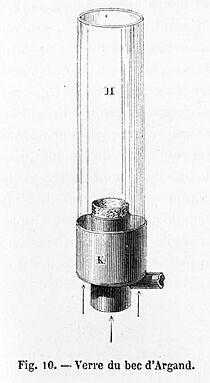
For a long time, lighthouses used wood fires or burning coal. This was very expensive. Some lighthouses used 400 tons of coal a year! Candles or oil lamps with curved mirrors were also used.
The Argand lamp, invented in 1782 by Swiss scientist Aimé Argand, changed lighthouse lighting. It created a steady, smokeless flame. The Argand lamp had a special wick that allowed air to flow through its center and around the outside. This made the flame steady and brighter. Early models used whale oil or other vegetable oils as fuel. The Argand lamp became the standard for lighthouses for over a century.
John Richardson Wigham was the first to use gas to light lighthouses. In 1865, he put his new gas burner at the Baily Lighthouse in Ireland. It was four times more powerful than oil lights. An improved design in 1868 was 13 times brighter than any light known at the time!
In 1870, the light at Wicklow Head used Wigham's special flashing system. It used clockwork to control the gas supply. When this was combined with a revolving Fresnel lens at Rockabill Lighthouse, it created the world's first lighthouse with a group-flashing light pattern. This meant the light would flash in a specific sequence, like groups of flashes.
The vaporized oil burner was invented in 1901 by Arthur Kitson. It made the fuel into a gas at high pressure and burned it to heat a special mantle. This made the light six times brighter than traditional oil lamps.
Using gas became much easier with the invention of the Dalén light by Swedish engineer Gustaf Dalén. In 1906, Dalén became chief engineer at the Gas Accumulator Company. He worked with acetylene gas, which is very bright but also very explosive. Dalén invented Agamassan (Aga), a material that could safely store the gas. Acetylene made an ultra-bright white light, quickly replacing other fuels.
Dalén also invented the 'sun valve'. This clever device allowed the light to turn on only at night, saving fuel. This meant lighthouses could run for over a year without needing more fuel. AGA lighthouse equipment didn't need electricity, so it was very reliable. For places with rugged coastlines like Scandinavia, these lights were a huge help for safety. AGA Lighthouses were even used along the entire Panama Canal. This technology was the main light source in lighthouses from the 1900s to the 1960s, when electric lighting became common.
The first electrically lit lighthouse was at Dungeness, England, in 1862. It used a large carbon arc lamp. But it was later changed back to oil because the arc lamps were hard to use and not as cheap as oil lamps. South Foreland Lighthouse was the first to successfully use an electric light in 1875. Its carbon arc lamps were powered by a steam-driven magneto.
Lighthouse Optics
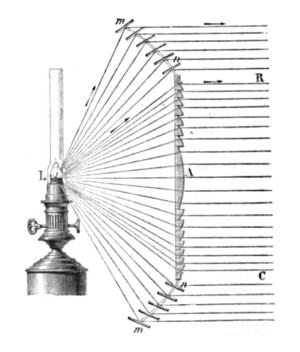
Once the Argand lamp provided a steady light, people could start using optical lenses to make the light brighter and more focused. William Hutchinson created the first useful optical system in 1763. He made curved mirrors by attaching small pieces of reflective material to a mold. This system focused the light into a strong beam, making it much more visible. His system was installed in the Leasowe Lighthouse near Liverpool.
Being able to focus the light led to the first revolving lighthouse beams. This meant the light would appear to sailors as a series of flashes. It also became possible to send complex signals using the light flashes.
The idea of making a thinner, lighter lens by using separate sections in a frame is often given to Georges-Louis Leclerc, Comte de Buffon.
However, it was the French physicist and engineer Augustin-Jean Fresnel who developed the multi-part Fresnel lens for lighthouses. His design allowed for large lenses that were much thinner and lighter than traditional ones. A Fresnel lens can also capture more light from the source. This means the light from a lighthouse with a Fresnel lens can be seen from much greater distances.
The first Fresnel lens was used in 1823 in the Cordouan Lighthouse in France. Its light could be seen from more than 20 miles (32 km) away. Scottish physicist Sir David Brewster helped convince British authorities to use these lenses in their lighthouses. Fresnel's invention made lighthouse lamps four times brighter, and his system is still used today.
See also


